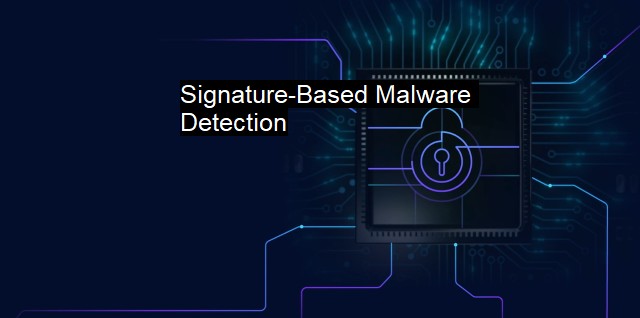What is Signature-Based Malware Detection?
Exploring Signature-Based Malware Detection: Building Digital DNA to Keep Cyber Threats at Bay
Signature-Based Malware Detection is fundamentally one of the essential techniques used designed to identify and eliminate both known and potential threats. Malware, a term merging 'malicious' and 'software,' encompasses a wide range of harmful programs, including viruses, spyware, adware, bots, worms, and Trojans, which can infiltrate and damage computer systems. Cybersecurity's scope, therefore, largely revolves around countering these threats that pose varying levels of harm to system integrity, user privacy, or data security. Consequently, the detection of such threats becomes functionally paramount and has nurtured the development of various mechanisms—including signature-based detection, heuristic-based detection, and behavior-based detection—used within antivirus applications.Signature-Based Malware Detection remains a pervasive standard across computational systems due to the practicality of its rudimentary concept of operation. Each type of malicious software has its unique signature—a unique set of characteristics or attribute strings typically based on binary code that it attaches to host files, like a digital fingerprint. This signature, specific to their code, provides a blueprint for identifying distinct malware variants.
Upon the discovery of a threat, developers of cybersecurity software investigate the malware, isolate its signature, then transmit that information into their network of users via consistent, mandatory updates. When the software scans system files for threats, it uses this database of signatures as a reference ledger, drawing comparisons between delivered content and covered malware signatures expectedly accurate in identifying the presence of contamination.
The effectiveness of signature-based malware detection lies in its unsurpassed competence at spotting-known malicious programs, casting it as a proactive, foreground defense in cybersecurity architecture. Users' systems are thus reliably protected against previously established threats making for a safer digital operating terrain.
Signature-based malware detection does contain limitations. It primarily remains incapable of identifying zero-day malware threats—nefarious software that has not yet been identified and whose signature has not been catalogued. Therefore, unless the signature database is regularly updated with the latest threats, this method would fail to detect new types of malware or advanced persistent threats (APTs).
Consequently, it renders traditional antivirus software less effective against newly designed malware making incognito debuts,landing the initial blows before their discovery and countermeasures can occur. Such a stance demands an emphasis on speedy threat documentation to protect as many users in as quick a time frame as possible.
Signature-Based Malware Detection, therefore, employs an inherently reactivity-based approach to cybersecurity. Dependably proficient in known threats, it contributes significantly but is inherently unable to address the complete gambit of potential cyberattacks. Hence, it is not, and never can genuinely be, a standalone protection strategy.
Rather, it coexists organically with other detection mechanisms like heuristic and behavioral checks to provide a multi-pronged defense. It underlines practical cybersecurity methodology that deals with ‘a layered approach,’ integrating various protective tools to create a well-rounded defense against all forms of malicious assaults.
Signature-Based Malware Detection is a formidable technique used to defend individual and collective security terrains within the context of cybersecurity. It leverages the propensity of malware to carry specific signatures, utilizing this attribute towards their identification and repellence. Its design advocates a proactive attitude towards cyberdefense, making the digital world a formidable battlefield for cyber operatives, malware developers, and regular users alike. As such, enhancing the competence of signature-seeking software through continued research, relentless attack documentation, and relentless passion for fine-tuning must always be the modus operandi for ensuring robust cyber health.

Signature-Based Malware Detection FAQs
What is signature-based malware detection?
Signature-based malware detection is a method used by antivirus software to identify and eradicate malware threats. It compares the signature or unique code of a file or program against a database of known malware signatures.How does signature-based malware detection work?
Signature-based malware detection identifies malware through the use of known patterns or signatures of malicious code. When a new file is scanned, it is compared to a database of known signatures, and if it matches any signatures, it is identified as malware. The antivirus software then removes or quarantines the infected file.What are the limitations of signature-based malware detection?
Signature-based malware detection is limited in its effectiveness against new, unknown malware or variants of existing malware. Attackers can easily modify the code of known malware to create new, undetected versions. This is why signature-based detection is often complemented with behavioral-based detection methods.What are the benefits of signature-based malware detection?
Signature-based malware detection is effective against known malware and can quickly detect and remove it. It is also a lightweight solution that doesn't require much processing power. Additionally, it is a widely used and standardized technique that is supported by most antivirus software.| | A | | | B | | | C | | | D | | | E | | | F | | | G | | | H | | | I | | | J | | | K | | | L | | | M | |
| | N | | | O | | | P | | | Q | | | R | | | S | | | T | | | U | | | V | | | W | | | X | | | Y | | | Z | |
| | 1 | | | 2 | | | 3 | | | 4 | | | 7 | | | 8 | | |||||||